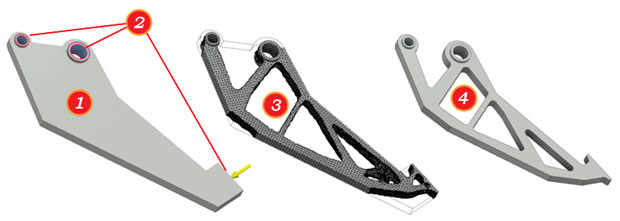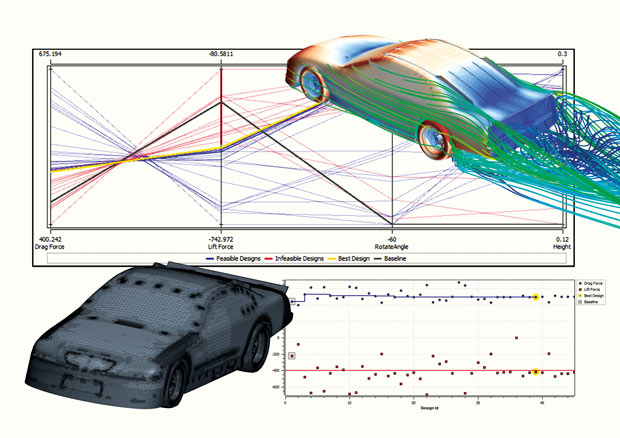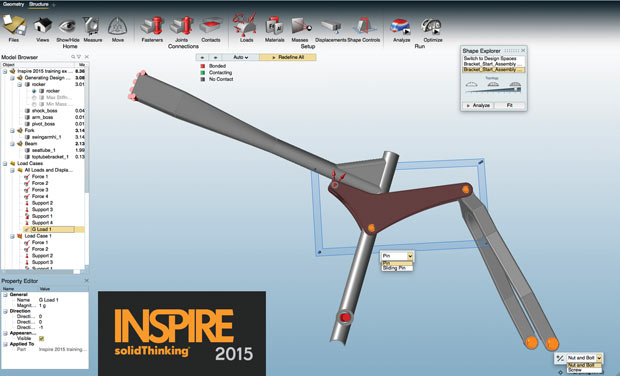
Shape Generator workflow: (1) Create a build volume or approximation of the part model; specify requisite contact points such as the two pin locations and the contact surface where force will be applied. (2) Specify preserve (keep out) zones that will not be modified when creating the guide shape; apply constraints and forces that the part may encounter in use. (3) Run a Shape Generator Study; receive back a mesh in response to the criteria. (4) Use the mesh as a guide for making modifications to the build volume model—user edits transform the model from an approximation into a design. Image courtesy of Autodesk.
Latest News
December 1, 2015
 Optimate+ is a CD-adapco STAR-CCM+ add-on that provides a scriptless solution for automation of design exploration to help engineers set up, execute and post-process design studies, which include parameter sweeps, DOE and optimization using the SHERPA algorithm from within STAR-CCM+. Image courtesy of CD-adapco.
Optimate+ is a CD-adapco STAR-CCM+ add-on that provides a scriptless solution for automation of design exploration to help engineers set up, execute and post-process design studies, which include parameter sweeps, DOE and optimization using the SHERPA algorithm from within STAR-CCM+. Image courtesy of CD-adapco.Recognizing the largely untapped value of digital simulation in new product development, more and more engineering organizations are leveraging their existing CAE assets with new, complementary investments in design space exploration and design optimization—technologies and methods that automatically exercise simulation, analysis and modeling applications to rationally and rapidly search through large numbers of design alternatives to identify the best possible designs.
These technologies began much the same as CAE, used chiefly by an elite group of experts for their most critical problems. But today, advances in usability, off-the-shelf connectors to all widely used modelers and solvers, and built-in (or easily captured) knowledge that guards against errors and misinterpretation of results are transforming these tools into practical, everyday engineering aids.
Topology Optimization Boosted by Additive Manufacturing
Of the technologies available for automated design exploration and optimization, the most widely used is likely structural optimization. Applying algorithms to solve structural problems by means of finite element analysis (FEA), this software optimizes some aspect of a product’s geometry—most often topology, shape, size, topometry or topography—to satisfy operating limits imposed on the response of the structure, and limits on the values that the structural parameters can assume.
Among the different kinds of structural optimization, topology optimization is currently the focus of greatest effort by software vendors to make it more accessible and easily applied by non-specialists.
An important driver of efforts to make topology optimization accessible to as many users as possible is the surge of activity around additive manufacturing. Often used to identify a conceptual design that best meets specified design requirements, topology optimization works by optimizing material layout within a given physical design volume for a specified set of loads and boundary conditions, so that the resulting layout meets prescribed performance targets. It frequently yields biomorphic-like shapes suited to additive manufacturing. These can then be modified for production by conventional subtractive manufacturing, if required.
Autodesk Within Generates Lightweight Designs
One vendor leading the move to democratize topology optimization is Autodesk. Autodesk Within, released in July 2015, is a set of generative design software solutions to help engineers create and 3D print lightweight designs for the automotive, aerospace, industrial equipment and medical implant industries. “Generative design, advances in material science, and new fabrication techniques are allowing engineers to deliver components that were never before possible. Autodesk Within enables designers to create high-performing parts while enforcing design rules and adhering to additive manufacturing constraints,” says Mark Davis, senior director of Design Research at Autodesk.
Based on technology from Autodesk’s 2014 acquisition of London-based Within Lab, Autodesk Within is built around an optimization engine that takes input parameters such as desired weight requirements, and maximum stress and displacement, then generates designs with variable-density lattice structures and surface skins to meet those specifications. The aim is to produce components that are both more high performance and lightweight, which are then refined for production by additive manufacturing.
Shape Generator Integrates Topology Optimization into Inventor
Another Autodesk initiative is Shape Generator, a new feature in Autodesk Inventor 2016 R2 (released October 2015) that provides topology optimization integrated directly into Inventor. Shape Generator is a conceptual design tool that generates a lightweight, structurally efficient 3D shape in response to a specified load case, using finite element methods to optimize material for the defined criteria. The user specifies boundary conditions, loads and target, then Shape Generator generates a 3D shape that can be used as a conceptual guide for preliminary design of a lightweight part.
 Shape Generator workflow: (1) Create a build volume or approximation of the part model; specify requisite contact points such as the two pin locations and the contact surface where force will be applied. (2) Specify preserve (keep out) zones that will not be modified when creating the guide shape; apply constraints and forces that the part may encounter in use. (3) Run a Shape Generator Study; receive back a mesh in response to the criteria. (4) Use the mesh as a guide for making modifications to the build volume model—user edits transform the model from an approximation into a design. Image courtesy of Autodesk.
Shape Generator workflow: (1) Create a build volume or approximation of the part model; specify requisite contact points such as the two pin locations and the contact surface where force will be applied. (2) Specify preserve (keep out) zones that will not be modified when creating the guide shape; apply constraints and forces that the part may encounter in use. (3) Run a Shape Generator Study; receive back a mesh in response to the criteria. (4) Use the mesh as a guide for making modifications to the build volume model—user edits transform the model from an approximation into a design. Image courtesy of Autodesk.Autodesk says that over time, generative design features will be incorporated into still more of its software portfolio. Much of this technology will come from Project Dreamcatcher, an initiative by the Autodesk Research organization to explore and expand the limits of generative design using cloud computing, natural-language input, pattern-based problem description and AI-assisted design space visualization.
Inspire 2015 Expands Structural Optimization to Assembly Models
Another product bringing structural optimization into conceptual design is solidThinking Inspire from solidThinking Inc., an Altair company. This software helps engineers, product designers and architects create and investigate structurally efficient concepts quickly and easily.
solidThinking Inspire 2015, released in June, significantly expanded the scope and complexity of problems the software can address. Most notably—and unlike many other volume-market optimization solutions—Inspire can now model, optimize and analyze product assemblies, not just individual components. “With support for assembly optimization, users can now incorporate a surrounding structure into their optimizations and gain a deeper understanding of the relationship between multiple components,” says Andrew Bartels, program manager for solidThinking Inspire.
OptiStruct Adds Lattice Structures, Advanced Materials
In addition to solidThinking Inspire, Altair continues to advance OptiStruct, one of the industry’s longest-established solutions for structural design and optimization. A structural analysis solver for linear and nonlinear problems under static and dynamic loadings, OptiStruct uses finite element and multibody dynamics technology, together with analysis and optimization algorithms, to help designers and engineers develop lightweight and structurally efficient designs. Recent releases offer novel solutions for design and optimization of 3D printed lattice structures and advanced materials such as laminate composites.
In keeping with OptiStruct’s 20-year history of introducing new capabilities, new functionality in the recent 13.0 release includes support for poroelastic (Biot’s equation) material properties, large-displacement nonlinear analysis, nonlinear heat transfer and more, according to the company.
The current OptiStruct 13.0.210 release features a new solution for design and optimization of 3D-printed lattice structures, which can provide design concepts for a blended solid-and-lattice structure or a lattice-only structure. The lattice structure can be fine-tuned through size optimization techniques to meet various performance requirements.
Design Space Exploration Software Speaks the Language of Engineers
Structural optimization is far from the only area of progress in leveraging simulation with powerful layers of intelligent automation that offer engineers more complete, higher-fidelity visibility into product performance earlier than was possible with older approaches. Equally important advances are coming in design space exploration—a category of software and methods that are beginning to radically advance the capabilities of engineers and multidisciplinary engineering teams to discover an array of feasible design concepts early; rapidly and fluently evaluate sensitivities, variants, and tradeoffs; then select the best candidates and optimize them. These include design of experiments (DOE), parameter and sensitivity studies, multidisciplinary optimization (MDO), multi-objective (Pareto) optimization and stochastic (robustness and reliability) optimization.
A focus of development across the industry is to make these tools easily and safely usable without requiring expert knowledge of the quantitative and algorithmic methods that underlie them. For example, users long had to know a fair amount about the array of statistical sampling methods to perform a DOE study—full factorial, fractional factorial, Latin hypercube and others—to choose one best suited to the particular problem being studied. In setting up complex multidisciplinary optimization runs, they needed some understanding of gradient-based vs. deterministic vs. heuristic solution methods, the issues involved in searching for local vs. global optima, and more.
Today, developers are removing these complexities by building in intelligence that lets their software make more and more of these decisions autonomously, based on the user’s description of the problem in engineering terms—in effect, making design exploration software speak the language of engineers and not mathematicians. This is a prime focus of development for Altair’s HyperStudy, CD-adapco’s Red Cedar Technology HEEDS MDO with its SHERPA search method, Dassault Systèmes’ SIMULIA Isight and the Design Optimization Roles in its 3DEXPERIENCE platform, ESTECO’s modeFRONTIER with its new pilOPT one-click self-adapting optimization algorithm, Exa’s PowerFLOW Optimization Solution, Noesis Solutions’ Optimus with its new Adaptive DOE techniques, and others.
Overcoming Market Development Constraints
Despite these technological advances, however, many more engineering organizations could be taking advantage of design space exploration and design optimization than do today. One reason is simply the constrained marketing and sales resources of some of the small, independent software developers that make up much of this industry segment. An example of what expanded market development resources can accomplish is Red Cedar Technology, which grew its billings more than 80% and tripled its customer base less than a year after its 2013 acquisition by CD-adapco.
Another constraint on adoption is that design exploration and optimization are not part of the standard work process at enough engineering organizations today. Too many still rely on intuition-based, hit-or-miss engineering practices, not recognizing how these new technologies for systematic, rational, software-enabled design discovery, exploration and optimization deliver benefits well beyond the costs of bringing them into the organization.
A related constraint is that design exploration and optimization are too often implemented at only the department or workgroup level. To have the greatest impact, the technologies and attendant work processes need to be recognized and given backing as enterprise capabilities. Achieving adoption at the institutional level:
- Eliminates burden of re-justifying tools and methods on every new project.
- Mitigates the problem of software and work processes falling into disuse between projects.
- Makes the technology more readily applicable across disciplines and domains—the wider this span, the greater its impact.
- Fosters systems thinking across project teams, helping discipline specialists raise their visibility into the project—and their contributions to it—up and out of their silo of expertise, to the systems and whole-product level.
- Facilitates capture and synthesis of expert knowledge from across the enterprise, then re-deployment of that knowledge enterprise-wide.
- Prominent examples include Ford’s adoption of ESTECO’s SOMO to enable an enterprise MDO system, BMW’s use of Noesis Solutions’ Optimus as its exclusive PIDO (process integration and design optimization) solution, and Rolls-Royce, whose aircraft engine development process is known for its longstanding institutionalization of design exploration, optimization and process integration based on SIMULIA’s Isight. Buoyed by these proof cases, and by the technology’s ever-increasing ease of implementation and use, design exploration and optimization use should continue to accelerate in the future.
More Info:
Subscribe to our FREE magazine, FREE email newsletters or both!
Latest News
About the Author
Bruce Jenkins is president of Ora Research (oraresearch.com), a research and advisory services firm focused on technology business strategy for 21st-century engineering practice.
Follow DE






